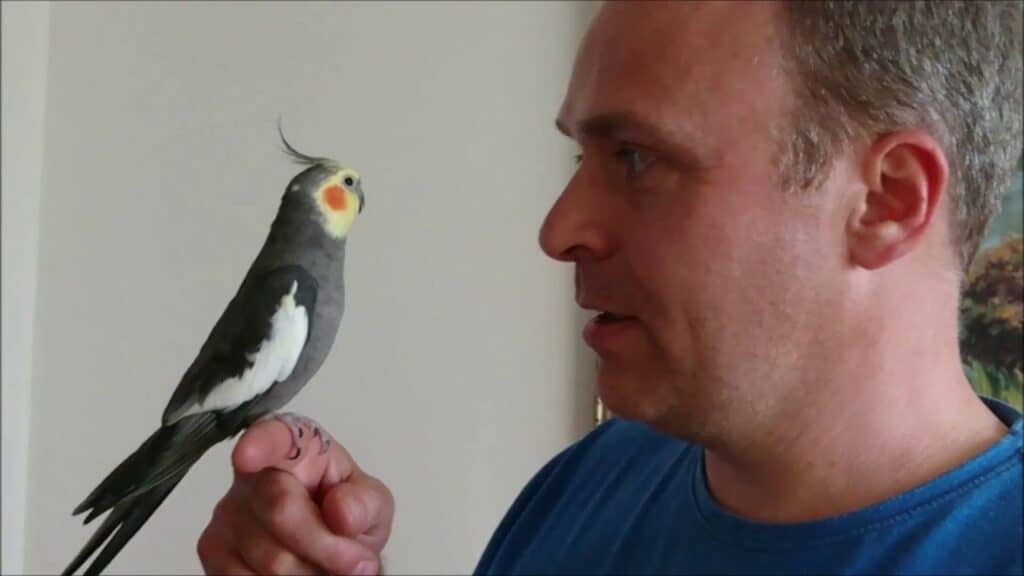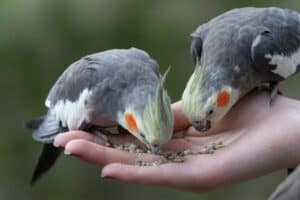Cockatiels are social and interactive birds. You must be wondering how these birds are able to socialize with their human fellows. Well, they can actually talk! Given their versatile personality, they are highly expressive birds. They show their emotions through their body language as well as words.

Can Cockatiels Talk?
Yes, Cockatiels can talk. Cockatiels can speak the human language. Cockatiels are friendly and very expressive pet birds. If you train properly in a good environment then they can talk with you and become your best friend.
The given article explores the numerous unique ways in which a Cockatiel talks.
How Do Cockatiels Talk?
Pets and animals usually have their own ways of communication. They have particular sets of sounds that they produce. These sounds have different meanings which can only be understood in bird language.
Surprisingly, cockatiels can speak the human language! These birds are quick-witted and intelligent. They can mimic human words with efficiency.
A detailed account of the various sounds, words, and phrases that cockatiels can produce is given below.
Different Cockatiel Sounds
1. Contact Call: Where Did You Go?
When a pet Cockatiel gets attached to you it will start wanting and needing your attention. If you leave the room, the Cockatiel is likely to respond with a chirping sound. This would mean that the bird is asking you that where you are going and when will you come back.
This signal is not only restricted to the owner. As you leave the room the Cockatiel will produce a contact call. You are supposed to respond to it by a whistle as soon as you get out of the bird’s sight.
2. Contact Call: Attention
This type of sound is reserved for the times when your bird needs to get your attention. In most cases this attention call will be produced in case the Cockatiel gets startled by something. Any sudden movement or loud noise which the bird perceives to be out of ordinary context will also serve as a stimulus to this lauder chirp.
3. Contact Call: Leave Me Alone
Sometimes the bird can get moody. In this situation, it will require you to leave it alone. The bird has different ways of showing this. Sometimes the bird will hold its feathers in an uptight manner. It will make hissing sounds.
If your Cockatiel feels threatened or senses anything dangerous, it will move to one corner of its cage and his like a snake. Most probably this behavior will be shown by unsocialized birds. If you have brought the pet home newly, it is likely to behave like this.
4. Contact Call: Sleep Time
When a Cockatiel is about to sleep it will probably inform you. During bedtime, it will produce some attention-seeking chirps.
This is your Cockatiels unique way of telling you that you should also go to bed. This is a nice gesture that gives the bird a sweet touch.
5. Happy Cockatiel Sound
When the bird is happy it will express its emotions. It is highly possible that the bird will produce a sound by grinding its beak. This is a sign that your bird feels happy and peaceful.
This indication can further be recognized by giving a closer look at the facial feathers of the Cockatiel. If they are fanned out over its beak while the rest of the feather is on the body if loved up, it is a clear sign that your Cockatiel is happy, joyful, and in a good mood.
Male vs Female Cockatiels Talk

You must be wondering how male and female cockatiels talk differently. The thing is that both have the equal capability of talking. Despite an equal capability, male cockatiels choose to be more talkative and expressive. However, their female counterparts are moody. They only choose to speak when they want to.
If you are looking for a talkative and more interactive cockatiel, go for a male. The male bird will keep you entertained with its abundant and frequent chirping.
How to Teach a Cockatiel to Talk?
Cockatiels do have the inherent ability to talk. However, it is important to train and teach them so that they can start talking.
There are many ways in which you can achieve this goal. A description of the methodology is given below.
1. Getting Comfortable
The first step is obviously to make the bird comfortable with you. The only way a Cockatiel can let you teacher is if it owns and accepts you as its master.
You will have to make a bond with your bird as the first and foremost thing to do. You have to interact with the bird as much and as frequently as possible.
2. Make Sure Your Cockatiel is Healthy
If your Cockatiel is healthy or sick, it will neither be an inactive talker nor a good respondent. In order to have healthy interactions with your Cockatiel, you must make sure that it is in the best of its health and spirits.
A healthy Cockatiel will be joyful and happy to talk. It is going to display interest in learning new human words. It will also imitate and mimic you in the best way possible. This shows that the health of a bird is the most important consideration to make while teaching it to talk.
3. Teaching the Cockatiel via Repetition
The most effective teaching technique has always been repetition. This is a process through which all organisms learn. Just like a baby human learns new words, the Cockatiel will too.
You must create a quiet space for your Cockatiel. After making sure that the environment encourages learning, you can start with your teaching lesson. You must keep your lesson short and precise. Choose one word and keep repeating it in front of the Cockatiel. This will allow your bird to focus on the lesson.
4. Reward the Cockatiel

If your bird gets the words right and shows enthusiasm in the learning process you can reward it. The reward could be a treat for the bird. You can also likely pet the Cockatiel to show your affection.
In order to make your Cockatiel a keen learner, you need to keep your lessons interesting. You can use different words in front of the Cockatiel and see that which one is its favorite. The bird will possibly be more enthusiastic about some words than others. You can use Cockatiel’s favorite words and strengthen their learning behavior with positive reinforcement.
Best Time to Train a Cockatiel to Talk
The best time to train a cockatiel to talk is around 8 to 10 months old. Cockatiels are the most receptive towards language learning when they are about 8 to 10 months old. Once the bird gets old it loses its vigor and motivation. It does not lose its ability, but the talking training becomes rather more time taking and difficult in the case of older Cockatiels.
Conclusion
All in all, it can be concluded that Cockatiels are talkative as well as smart. Especially during their young age and generally throughout their lifetime, the bird remains interactive and social. If you use the correct techniques and train your bird well, you can have a good time with an interactive Cockatiel.
FAQ
1. Can Cockatiels Talk like Parrots?
Like other birds, Cockatiels also have syrinx which allows them to adapt to vocals that are like humans.
2. Do Cockatiels like to be talked to?
Cockatiels are friendly and talkative birds. They do like to talk a lot.
Last Updated on March 22, 2023 by Lily Aldrin
